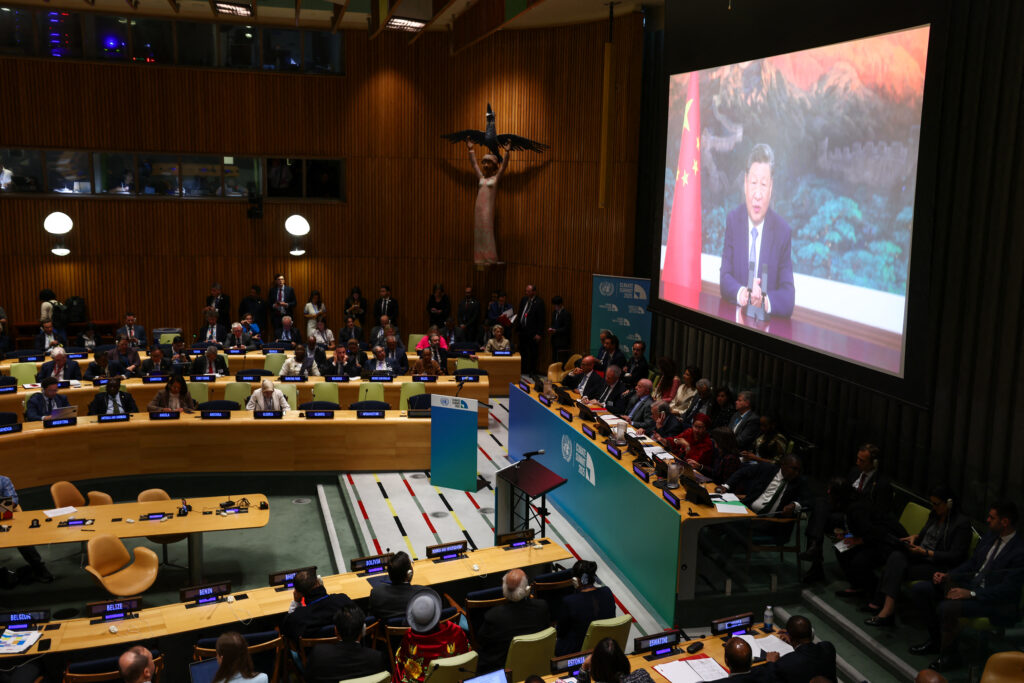Over the past two weeks, leaders from more than 175 countries have gathered in Cali, Colombia, for the 16th gathering of parties to the United Nations Convention on Biological Diversity. The topic at hand? Preventing the utter collapse of nature, which is well underway, according to a wide body of research.
A suite of strategies could help prevent this, but they cost money—and lots of it. Experts estimate that we will need roughly $700 billion each year to fund the scale of conservation necessary to combat widespread biodiversity loss, on top of what countries already spend.
One of the main agenda items at the UN biodiversity talks is figuring out where this money will come from. The meeting is set to end today, but talks are ongoing. While there was some progress on this front, countries are still at odds about who will bear the brunt of these costs—and how.
Closing the Gap: Members that signed on to the UN’s Convention on Biological Diversity (a treaty from which the U.S. is notably absent) agreed in 2022 on a historic plan to “halt and reverse nature loss.” This global biodiversity framework outlines more than 20 targets and goals for countries to meet by the end of the decade, including protecting 30 percent of land and seas.
To do that, the plan says we must close the $700 billion financing gap. This may sound like a lot but, as Vox’s Benji Jones points out, it pales in comparison to global gross domestic product, which adds up to more than $100 trillion. Increased funding would be used to help nations, especially in developing countries and Indigenous lands, conserve nature within their borders by establishing protected areas, completing restoration projects and increasing sustainability on farms.
Countries agreed to submit their individual plans to meet biodiversity targets by the start of this year’s UN talks. However, more than 80 percent of member parties missed the deadline. A few more governments have put forth plans in the past two weeks, but progress is still lagging, according to Tanya Sanerib, international legal director at the Center for Biological Diversity, a conservation nonprofit.
“It doesn’t signal that we’re taking this next step very seriously, and it gives a really sound indicator that we maybe are going to be in deep trouble in terms of actually trying to meet the framework that the party set at the last [UN biodiversity talks],” she told me. “We’re way behind the ball.”
Experts say the majority of the funding gap could be addressed by reducing subsidies that fuel the destruction of nature. By some estimates, wealthy countries and businesses provide around $1.7 trillion in subsidies and tax incentives for agriculture, fishing, fossil fuel development and other industries. This week, several world leaders and nonprofits called for a rapid phaseout of these incentives, Justin Catanoso reports for Mongabay.
“We use nature because it is valuable. We abuse nature because it is free,” Barry Gardiner, a long-time Labour Party member of the British Parliament, said Sunday at COP16. “The failure to properly value nature leads to shortsighted decision making, and perverse subsidies that damage the global ecosystem.”
Deliberations over finances are ongoing.
The Biodiversity Credit Debate: Even if countries are able to reform their economies to support nature, conservation efforts will still require several hundred billion dollars to meet global biodiversity goals.
Under the biodiversity framework, much of this funding will come directly from national governments. But experts say it must also come from donors and the private sector. In recent years, a new and somewhat controversial idea has emerged to create an economic market for conservation through the sale of “biodiversity credits.”
On its surface, the premise is somewhat simple: A biodiversity credit represents a certain amount of nature conserved or restored over a specific period of time. Companies could buy these credits to go toward their own nature conservation goals.
In some ways, it’s similar to the carbon trading market, which enables companies to offset their emissions by investing in a project that reduces emissions somewhere else in the form of a “carbon offset,” which my colleague Nicholas Kusnetz wrote about in March.
However, biodiversity credits are distinct because they are not tied to losses elsewhere and are intended to have a net-positive impact on nature. That means companies cannot use them to hypothetically compensate for the nature that they destroy in their supply chain, except under strict criteria, according to a UN-backed advisory panel. On Monday, the group published an official outline for a “high-integrity” biodiversity credit market.
But some researchers and nonprofits worry biodiversity credits mirror many of the same issues that the carbon offset market has been criticized for.
“You’re roughly just doing cut and paste of the carbon market with minor tweaks,” Mitch Aide, a research associate at the Smithsonian’s National Zoo and Conservation Biology Institute, told me. He recently published a paper outlining some of the potential flaws in the biodiversity credit market, which is still in its early days.
One of the paper’s main points is that wildlife and plants are more complex and unpredictable than carbon. It is difficult to determine how much conservation activities increase biodiversity in a given area compared to its baseline if the project didn’t exist, especially when you throw climate change into the mix. Therefore, there is little standardization across the biodiversity credit market—and no independent validation panel to approve projects, Aide said.
At this week’s UN talks, multiple discussions centered around developing this market as several companies charged forward with plans to create their own biodiversity credits, Carbon Pulse reports. This triggered backlash from some Indigenous groups and nonprofits like Greenpeace and the Center for Biological Diversity.
“We really have to flip a lot of crucial things that we do right now in the current economic system to be able to get it to actually work for protecting and restoring biodiversity in the way that we know that we need to,” Sanerib said. “Tinkering about with credits isn’t going to accomplish that. Yes, we need some new, novel, innovative ways of trying to address some of these things, but I personally just don’t think that credits are going to get us there.”
More Top Climate News
The U.S. is now just four days from the presidential election, the outcome of which will have profound implications for the climate. A new analysis reveals that oil and gas interests have donated an estimated $75 million to the Trump campaign, the Republican National Committee and affiliated committees. The New York Times’ Lisa Friedman points out that this analysis “is just the campaign cash that can be found in public records; donations made to nonprofits such as 501(c)(4) organizations, also known as dark money, are usually not publicly disclosed.”
Former President Donald Trump previously promised to undo certain environmental regulations that would open the door for even more oil and gas development if the industry donates a billion dollars to his campaign. He cemented his support for the industry with a frequently uttered mantra: “Drill, baby, drill.”
Meanwhile, in Spain, torrential downpours triggered catastrophic flooding in Valencia earlier this week, killing more than 200 people. Cars piled up along narrow streets after being swept up in the floods, making it hard for emergency responders to comb through mud and debris to find survivors. An analysis by World Weather Attribution found that climate change made Spain’s rainfall roughly 12 percent heavier and doubled the likelihood of the intense storm. More bad weather could be on the horizon for the city, Jon Henley and Sam Jones report for The Guardian.
There is a severe labor shortage in the U.S. farming industry, and more companies are turning toward automation to fill the gap, Ayurella Horn-Muller and Melina Walling report for Grist. The machines could help protect outdoor farmworkers from extreme heat, but some are concerned that this trend may roll back rights for employees or lead to further exploitation of nature.
Due to unusually high autumn temperatures, Mount Fuji experienced its first snowless October in 130 years, according to the Japan Meteorological Agency. This is part of a long-term trend as climate change reduces snowpack across many regions in the Northern Hemisphere.
“The atmosphere at the summit has definitely warmed considerably since 1970,” Andrew Bernstein, a professor of history at Lewis and Clark College in Portland, told ABC News.
On Wednesday, Los Angeles County filed a lawsuit against PepsiCo and Coca-Cola for misleading the public about the recyclability of their plastic bottles, Jaimie Ding reports for The Associated Press. The two companies are among the top plastic polluters in the world, according to watchdog environmental group Break Free From Plastic. The American Beverage Association, an industry group that includes PepsiCo and Coca-Cola, denies the allegation that the two companies’ bottles are not recyclable.
About This Story
Perhaps you noticed: This story, like all the news we publish, is free to read. That’s because Inside Climate News is a 501c3 nonprofit organization. We do not charge a subscription fee, lock our news behind a paywall, or clutter our website with ads. We make our news on climate and the environment freely available to you and anyone who wants it.
That’s not all. We also share our news for free with scores of other media organizations around the country. Many of them can’t afford to do environmental journalism of their own. We’ve built bureaus from coast to coast to report local stories, collaborate with local newsrooms and co-publish articles so that this vital work is shared as widely as possible.
Two of us launched ICN in 2007. Six years later we earned a Pulitzer Prize for National Reporting, and now we run the oldest and largest dedicated climate newsroom in the nation. We tell the story in all its complexity. We hold polluters accountable. We expose environmental injustice. We debunk misinformation. We scrutinize solutions and inspire action.
Donations from readers like you fund every aspect of what we do. If you don’t already, will you support our ongoing work, our reporting on the biggest crisis facing our planet, and help us reach even more readers in more places?
Please take a moment to make a tax-deductible donation. Every one of them makes a difference.
Thank you,

















